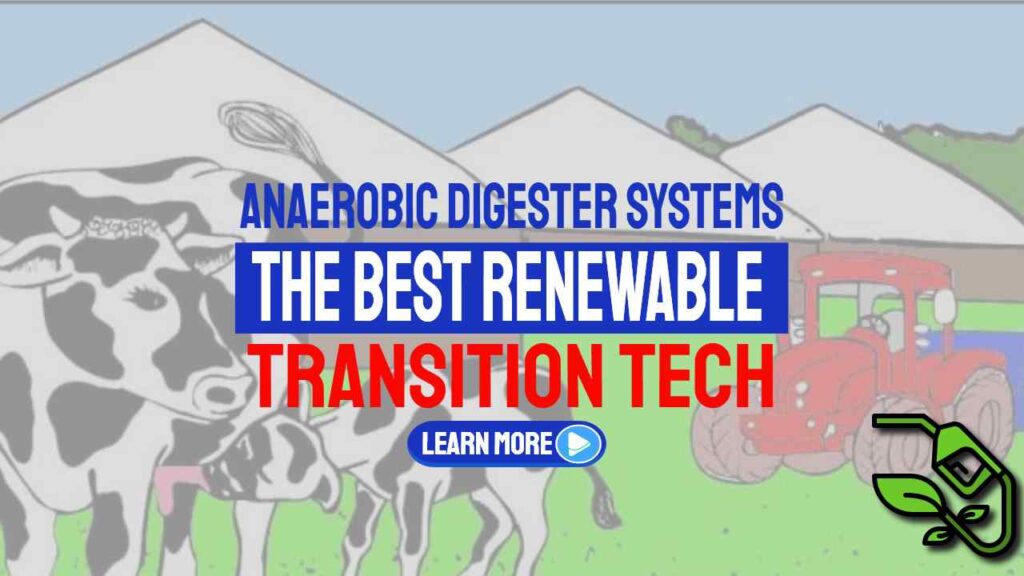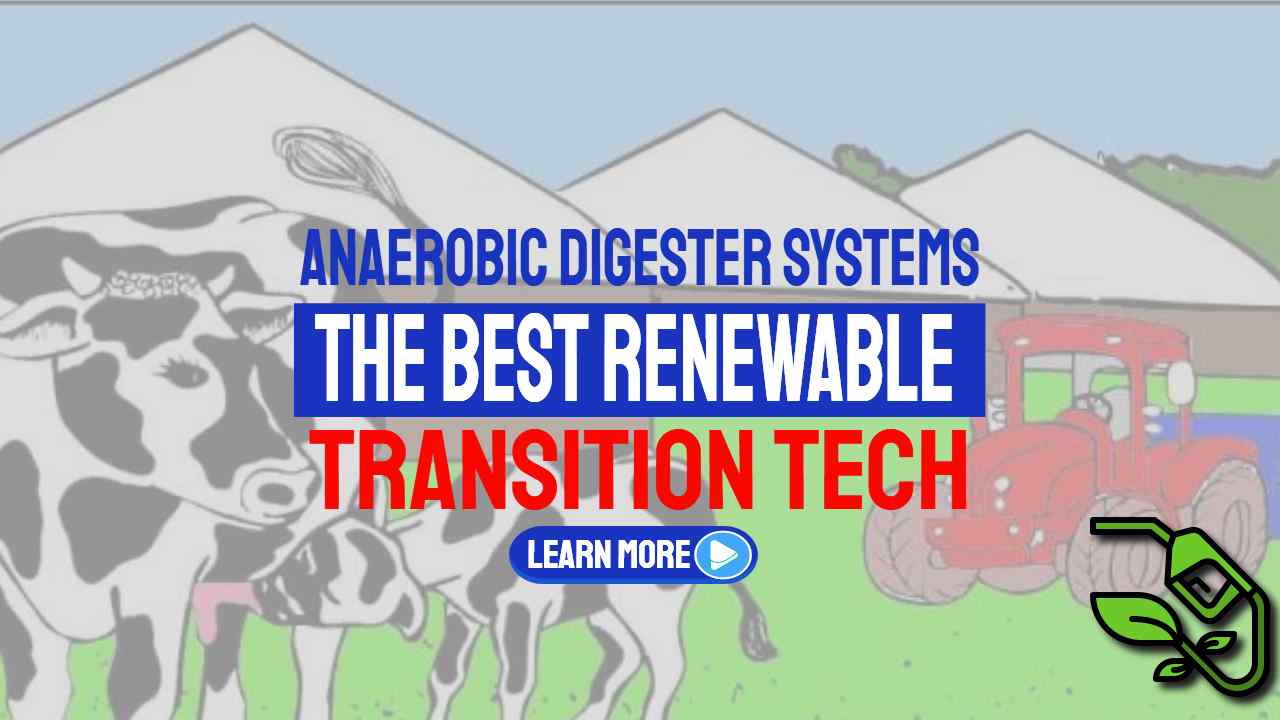Anaerobic digester systems are an environmentally sound way to decompose organic waste. They do this without oxygen, making them much cheaper to maintain and operate than aerobic systems which need energy-sucking high powered oxygenation equipment to work at all. In addition, these systems are able to manage high strength organic waste, which can be more challenging to handle with a traditional aerobic treatment system.
This article examines the pros and cons of anaerobic digestion systems. This article will give you some useful tips for constructing your own digester.
The Origins of Anaerobic Digester Technology
Anaerobic digester technology dates back to the 18th century when Sir Humphry Davy discovered the presence of methane in cattle manure gases. In 1859, the first known anaerobic digester was constructed in a leper colony in Bombay, India. In 1895, the city of Exeter, England, developed a septic tank with an anaerobic process. It generated gas for the sewer gas destructor lamp, which was used to treat the sewer. In 1904, a dual-purpose septic tank was built in Hampton, London.
Digester Maintenance
Proper maintenance is essential to the operation of anaerobic digester systems. For the best results, you should perform routine inspections and cleanings of your anaerobic digester system. If you have a commercial or industrial facility, it is vital to check your anaerobic digester system on a regular basis. This will ensure its continued operation and extend its lifespan. Further, proper maintenance will also save you money in the long run.
If you want to build an anaerobic digester, it’s important to know how to maintain it properly. You should conduct periodic checks of the digester’s pH, and alkalinity and make sure its valves are free to operate and that the pipework is not clogged. If you don’t feel confident with your maintenance skills, it is worth spending a little more by engaging an expert maintenance contractor to get the best out of the system. Once you’ve built an anaerobic digester, you’ll have a much longer life expectancy.
Benefits of Anaerobic Digester Systems
There are quite a few benefits to anaerobic digester systems. The most obvious one is the reduced cost of electricity. The sewage produced by anaerobic digester systems will be significantly cheaper than traditional wastewater treatment. In addition to saving you money, you’ll have less strain on the community sewer system. You’ll also be reducing the amount of wastewater you discharge. It’s worth considering an anaerobic digester system for your business!
Skills You Need To Know to Feed A Digester
Although anaerobic digester systems may seem simple, they require a lot of skill to feed them suitable organic waste compared to other methods of manure management. You may need to hire additional employees to take care of the system and in the UK they may need to be WAMITAB Certified.
However, a properly designed commercial biogas digester system will be instrumented to automatically open and close the valve and run the pumps when needed and without operator intervention. Some systems require the operator to do no more than press the right buttons when it is time to remove the excess sludge and biogas produced by the anaerobic digester. In contrast, a poorly designed system will tend to clog and when that happens the SCADA system will also fail and the whole biogas plant system will need to be maintained manually.
Routine Inspections Biogas Systems Need
Anaerobic digester systems need to be routinely inspected to ensure that the biogas produced is safe and effective. You’ll need to check the inlet and exit pipelines to ensure that the biogas is flowing correctly. This is an important part of a waste management system, so it’s important to choose feedstocks wisely. A successful anaerobic digester system will be able to reduce energy and water usage by up to 60% as long as the regular checks are done well and any problems are tackled promptly once found.
A digester is a little like a live animal. When ill they need to see the vet so that they can be treated and brought back into health. The digester is full of microorganisms and they need to be kept healthy. If not well it may not be long before they start to die and when that happens the biogas flow stops and so does the revenue of payment for the energy the system produces also stop.
Anaerobic digesters should be checked regularly. Each one should be inspected every six to eight weeks by reviewing operating data, and not forgetting to walk around and listen for any noises which indicate a malfunctioning pump or mixer gearbox in the system which needs repairing. There is no higher priority than to keep on checking each day to ensure that it is all working properly.
Get Paid More by Exporting Electricity only when You Will Get paid the Most for it
While a large digester can be used to generate electricity for the farmhouse and all the buildings including the barns, it’s too much power for just a few small homes. Instead, you can power a whole housing development night and day and the payments you receive for the electricity can be huge. And as a result, you can sell biogas at a high price.
In these cases, you should consider the power capacity of the anaerobic digester system before purchasing one. Don’t forget that although your digester can easily provide power non-stop, it may be that you can get paid more by exporting your electricity during peak demand periods alone. You can discuss with your technology provider how many hours a day your anaerobic digester should operate at the peak in order to make the most money by being paid extra to provide power when there is a storm or a power shortage.
Uses for Anaerobic Digesters
While anaerobic digesters are best suited for agriculture, they can also be used to process other waste materials. For example, food processing residuals such as whey and beer can be converted to biogas that is then sold. Additionally, distillery waste can be used as a feedstock for anaerobic digesters. These are just a few of the reasons why anaerobic digesters are an increasingly useful method of waste management.
Anaerobic digesters are used for energy production. They are beneficial to all types of industries and businesses. They produce biogas and digestate outputs. Both are valuable. This makes the process more cost-efficient.
Digestate is a Valuable Fertiliser
Digestate is a valuable natural fertiliser. Aside from the biogas produced, anaerobic digestion processes are also efficient in reducing the pollution loading below the water-borne pollution which occurs when. Some even produce electricity and heat through their waste. The resulting gas is called “biogas” until it is cleaned up by additional purification processes. There are also benefits for companies that use anaerobic digestion when they write their net-zero emissions reduction plans.
Benefits of Anaerobic Digestion
Once the process is complete, the products will be digested into bio-gas or digestate. It has many advantages over other methods. Listed below are some of the key factors that should be considered in a system before you start it.
Anaerobic digestion is an energy-efficient process that can be used to reduce the amount of waste in landfills. It is an excellent alternative to fossil fuels, and the methane from anaerobic digestion plants is used in the electricity grid to power homes, industries, and other facilities. It is carbon neutral and can replace fossil fuels. It has many advantages for the environment. The process can even help the environment.
Anaerobic digestion can produce methane and carbon dioxide in large quantities. It is an efficient alternative to landfill, and every tonne of food waste processed in anaerobic digestion prevents around 0.5 to 1.0 tonnes of CO2 from entering the atmosphere. This is just one of the many benefits of anaerobic digestion. So, what are the benefits of anaerobic digestion?
Anaerobic Digestion is a Great Investment Opportunity
Anaerobic digestion is a great investment opportunity that helps the environment and provides financial returns. It is also beneficial to the local community, farmers, energy entrepreneurs, and the government. The only downside of anaerobic digestion is the capital investment. It requires a significant investment, but the benefits are worth it in the end. And the delayed returns can be easily absorbed by a cash flow model. There are several advantages to anaerobic digestion and the benefits it can bring.
Among the benefits of anaerobic digestion is the environmental benefits. The process is sustainable and produces no harmful waste. It is not only environmentally friendly but also creates renewable energy. It is a great choice for any business. If you are interested in anaerobic digestion, make sure you research it carefully. It is an excellent option for companies to consider for your waste management needs. There are many benefits of anaerobic digestion.
An Excellent Way to Recycle Organic Wastes
Anaerobic digestion is a great way to recycle organic wastes. Using this process, you can get rid of harmful pathogens in the process. This method is a great investment for both your community and the environment. Aside from being environmentally friendly, anaerobic digestion can also yield direct financial benefits for your business. It can also help you save money by providing a valuable service. It can be beneficial to your local economy.
Most systems for anaerobic digestion are highly integrated, and in the latest systems, the components of an anaerobic digester are designed to provide much higher gas yields than in the past. The main components of anaerobic digestion plants include:
- tanks,
- mixers,
- heating systems, and
- covers.
There are three main types of anaerobic digestion tank systems:
- a complete mix digester (CSTR)
- a batch flow digester, and a
- plug flow anaerobic digester.
Each of these processes requires a different type of equipment to operate.
Modular Anaerobic Digestion Systems
A modular anaerobic digestion system allows for maximum flexibility. It can be designed to process a wide range of feedstocks.
After the anaerobic digestion stage, the organic material passes through a pre-processing stage for substrate conditioning. All plastic bags are opened in a depackager and separator unit to release the purest possible organic material output. A depackager and separator unit may reduce particle size, but not while smashing up the plastic pieces too small. That’s because that would create unwanted microplastics with all the worries for the health of little creatures that microplastics pollution entails.
A modular anaerobic digester is a versatile system that at the same time allows for the most flexibility. The modules can be used to process a variety of different organic feedstocks. This system is designed to process a variety of feedstocks and is highly flexible. It can also be customized to meet the specific needs of the client. This flexibility is crucial when building a plant for anaerobic digestion.
A Cost-effective Method of Biogas Production
Anaerobic digestion is a cost-effective method of biogas production. A single anaerobic digester can reduce up to 50% of the mass of the incoming feed during the process. The process is also environmentally friendly, it reduces greenhouse gas emissions and needs no dewatering chemicals.
However, there are some disadvantages to anaerobic digestion. The plants must be very conscientiously looked after or they can become a bit of a nuisance and make some smells. The odour is less though than produced when spreading uncomposted farm waste on land.
This is an environmentally beneficial option for agricultural wastes which is becoming very popular in the EU states. You can find out why this is so, here: https://eurobic11.com/8-things-to-know-about-anaerobic-digestion-in-europe/








Your exploration of anaerobic digesters is thought-provoking and highlights a critical intersection of environmental sustainability and technological innovation. The historical context you provided enriches our understanding of how these systems have evolved over time, revealing that the concepts behind anaerobic digestion aren’t new, yet they are incredibly relevant as we navigate contemporary waste management challenges.
I appreciate your thoughts on the historical context of anaerobic digesters. It’s interesting to think about how these systems have roots in practices that date back centuries, yet their relevance today is sharper than ever. The challenge we face with waste management isn’t just about finding new technologies, but also understanding and revitalizing these age-old methods that promote sustainability.
It’s fascinating to see how these historical practices continue to resonate with our modern challenges, isn’t it? The roots of anaerobic digesters really do tell a story about human ingenuity in managing waste. I often think about how our contemporary society can sometimes overlook the wisdom embedded in traditional methods.
I recently came across an article that dives into the role of methane in our climate challenges, highlighting how understanding its impact can connect our historical waste practices to modern sustainability efforts.
‘Methane is a Greenhouse Gas & Crucial Player in Climate Fight’
https://stop-global-warming.co.uk/methane-is-a-greenhouse-gas-crucial-player-in-climate-fight/.
Your observation about the historical context of anaerobic digestion really resonates with me. It’s fascinating how techniques that have been around for centuries are suddenly finding renewed relevance in our fight against waste and climate change. I often think about how our ancestors utilized these natural processes without fully understanding the science behind them. It’s a reminder that sometimes the solutions to modern problems can be found in old practices.
It’s interesting to think about how much we stand to learn from our ancestors. They had an intuitive understanding of the natural world that often eludes us today, especially as we become more entrenched in our technology-driven lives. There’s something humbling in recognizing that while we’ve made scientific advancements, many of the solutions to our current issues were already known to those who came before us.
You bring up some really compelling points about our ancestors and their connection to the natural world. It’s fascinating to think about how their everyday lives were so intertwined with the rhythms of nature. They had this deep-seated knowledge and respect for their environment that we sometimes seem to overlook in our current tech-centric existence. It makes you wonder what we’ve lost in the hustle of modern life.
I find that perspective really intriguing. It’s true; there’s something deeply comforting knowing that our ancestors had a grasp on these natural processes, even if their understanding wasn’t framed in scientific terms. It seems like they had a different relationship with their environment, where sustainability was just a part of daily life.
I completely agree with you; it’s intriguing how practices like anaerobic digestion show up in different forms throughout history. It makes me think about the broader theme of sustainability and how wisdom from the past can guide us in creating a more balanced relationship with our environment.
I totally agree; it’s intriguing how we can draw from ancient practices in our modern quest for sustainability, and this piece explores how biomethane is stepping into the spotlight as a viable solution for HGVs.
‘Biomethane Questions and Answers – Sustainable Fuel for HGVs’
https://stop-global-warming.co.uk/biomethane-questions-and-answers-sustainable-fuel-for-hgvs/.
I appreciate your thoughts on the fascinating intersection of ancient practices and modern sustainability efforts. The concept of using biomethane as a fuel source for HGVs not only highlights how we can leverage historical wisdom, but it also showcases a practical solution to pressing environmental challenges today.